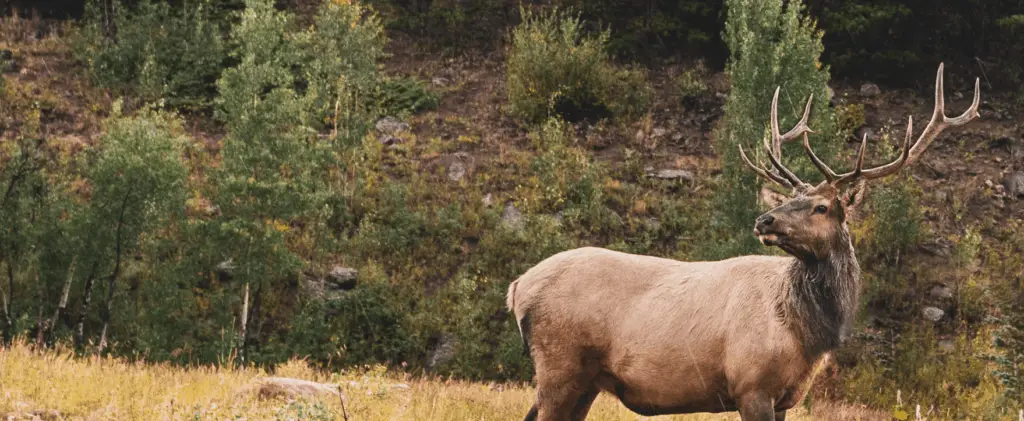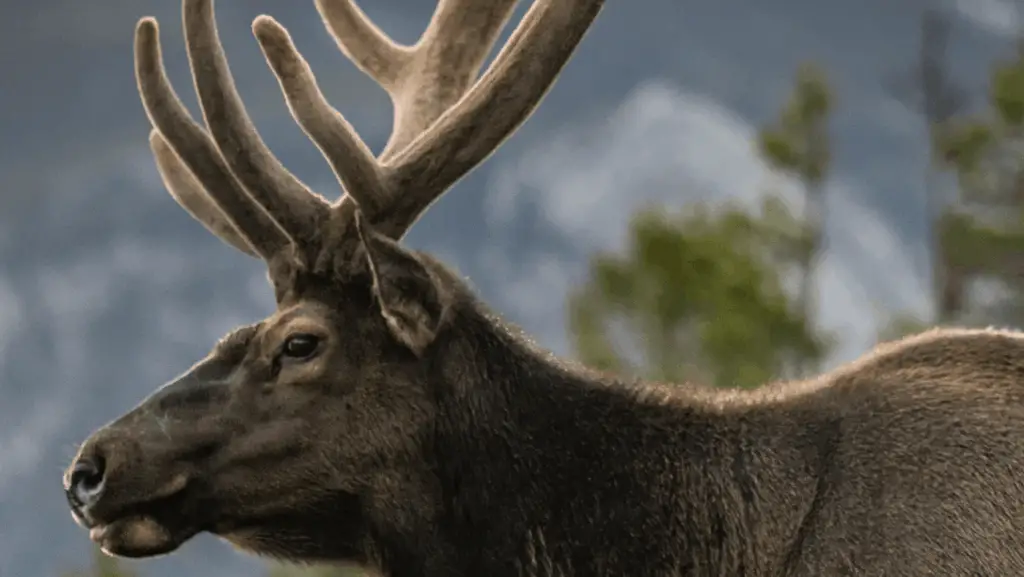As an Amazon Associate I earn from qualifying purchases.
Our Associate portal can be found here
If you’ve ever put down an elk, then you’ve probably heard him bugle. An elk bugle is a warning, a declaration, a cry for help, and a signal that the rut is on. As a hunter, learning about elk sounds will help you make similar calls or they’ll help you easily locate an elk. So, do elk bugle in the spring?
Across North America, elk bugle all year round, except in late summer when this vocalization subsides. Bulls are noisy during the rut or breeding season, which starts in early September to mid-October. Elk cows bugle mainly in the spring calving season.
While elks do make other noises, bugle calls are the most definitive. Read on as I describe the elk bugle, its cause, meaning, and results, plus whether you can hear it in the spring.

Is It a Bugle or a High-Shrill Bark?
The captivating cry of the American elk carries far, over woods and mountains to warn off amorous rivals or attract receptive cows. Bugles are not a one-season thing. You can hear them from males or females, with each vocalization carrying differing messages in various seasons. During spring, you’ll hear an assortment of mews and chirps alongside grunts and barks, which elk use to talk to each other.
Being a herd animal, elks have specific communication skills when the animals are on the move, rest, or special occasions like the rut. Barks, just like some bugles, are warning signs, while are for when an elk wants another to show itself. You’ll also hear elk moan, whine, cry, and hiss, stomp hooves or rattle their antlers against tree branches.
However, the sounds that carry further and capture hunter’s hearts are chuckles and elk bugles. You’ll hear them inside dark timbers and around river breaks, in the morning, before dusk, or all night long. Sometimes, at noon, a bull elk will bugle to sound off and declare to all and sundry how much he’s worth in terms of harem size.
What Do Elk Bugle in the Spring Calls Mean?
It’s easy to call an elk bugle a mating call, but that’s not always the message.

For instance, in late August and early September, you’re likely to hear elk bulls making the locate bugle. This vocalization consists of a one to two-second high, double note, a non-aggressive call meant to keep the herd in touch.
In spring, it’s common to hear a scream bugle, which is a bull-to-bull communication meant to put a subordinate animal in its place, establishing dominance. The scream bugle can also be addressed to cows, a high-pitched and clear herding call bugle that’s different from the call for threatening rivals. This bugle is atonal and coarse.
A full bugle is the one you’ll hear most, often during the rut and in times of herd movement. This classic call made by irritated bulls, starts with a low growl that heightens several notes to culminate in a grunt. Bulls use full bugles while displaying a full head of antlers for social worthiness and breeding ranking.
The Female Elk Spring Bugle Call
In spring, between May and June, the most common elk bugle call comes from the birthing cows. While these calls are rare, they are pretty different in acoustic nature from the ones that the bulls produce.
You can also hear non-aggressive bugles within this herd when there are no adult males in sight. Such vocalizations occur when cows and the young congregate while feeding or while resting.
Some bugles are also emitted in an aggressive context when female squabbles occur. You’ll often see this in the spring when a dominant cow is chasing a subordinate interloper. There’s a discernible difference in the duration, rate, and context of male and female bugle calls, as well as the time of day when they make them.

Spring bugle calls from cow elks are a result of hormonal changes and high-stress situations. They are common at the end of gestation and the lactation period. Whereas bulls will bugle more during dusk and dawn in the fall, females prefer the late morning hours. During their peak calling hours, cows bugle one call a day compared to the males, who do so at an average of one call per minute.
How Far Away Can You Hear an Elk Bugle?
An elk bugle call can carry anywhere from 100 to 1,500 yards depending on vegetation, topography, weather, and atmospheric pressure conditions. Hearing the resonating bugle will also depend on which way the animal is facing, the temperature, and the time of day. Elk calls tend to travel further early morning, late evening, and at night.
When an elk is bugling near trees with the wind rustling leaves or streams splashing over rocks nearby, your ability to hear its bugle is reduced to less than 200 yards. However, if you stand at an elevated position with hills all around, you’ll catch an elk’s bugle from over 400 yards or more.
What Sounds Are You Likely To Hear From Elk during the Spring?
Hearing an elk’s call echoing across their range sets the pace for a hunter as soon after the stalk will begin. It’s important to know what sounds you hear from elk and whether they’re coming from bulls or cows if you are to draw out your target animal for a kill shot.
While you may recognize the bugle of an elk, this multi-sound with low transitions can be hard to gauge for a message. Is it a warning call or a dominance establishing boast? While you can judge the sex of the caller by the intensity of their bugle, you can use the sound to pinpoint their location. You can use your call-backs to attract the prime bull to go into a challenge against his territory, but that works better during the rut.

In the spring, cow elk bugling calls are at their peak, but other sounds you should learn to associate with the animal include;
Glunk
While this sound is more common during the breeding season, you may hear bulls intoning muffled bass glunks in singular notes. Male elk will vocalize glunting in quick succession when talking to a herd of cows. If you catch solitary spring males making these calls, chances are the females are nearby.
Chuckle
At the end of a full or scream bugle, an elk bull will produce what sounds like a chuckle. These are a series of grunts that express dominance and attract cows. Chuckling is an excellent addition to your bugling calls, and you can imitate males who chuckle without an accompanying bugle.
Bark
Any elk, but especially the dominant bull or the herd matriarch, can utter barks. These calls alert the herd of imminent danger and involve a short, sharp blurt. If you hear a bark, your target herd will soon be mobile, meaning they’ve already spotted you and your stalk winded.
Estrus Bugle
While this is a rare spring occurrence, cows will voice estrus bugles when they’re on heat. This bugle sounds like a high-pitched whine but doesn’t last that long. Imitating this call is essential to stop an elk bull that you’re stalking or locate a herd.
Calf Mews
The call of an elk calf sounds like that of a female elk but with a lower intonation. Like a squeak, calf mews will have the mother cow responding, especially when there’s a desperate bleating to signal a lost juvenile. If you are hunting elk cows, this call will bring them within shot range, while a bull might come to investigate the safety of his herd.
Elk Chirps
You’ll often hear this elk call in the spring as the animals communicate when congregating as a herd. While these vocalizations are common, they don’t mean much except to showcase camaraderie and contentment when feeding together. Along with calf mews, chirps make up the bulk of elk sounds you’ll hear on your spring hunt.
Apart From Spring, What Other Season Do Elk Bugling Peak?
Elk will bugle until they run out of breath during the runt. From late September to mid-October, this season is filled with bulges and counter-bulges as bull elks compete and serenade simultaneously. Cows that come into estrus are also known to let out a lower, shorter bugle than their amorous mates.
Rut bulging reaches frenzy in the evening, and sometimes when competition is high, it will continue throughout the night. At this time, young or spiked bulls are earnestly bugling to attract receptive cows from the all-female herd.

At the height of rut bulging, you’ll notice mating behavior as bulls posture, swing antlers, thrash bushes, and trees, or spar with one another. Receptive cows will be attracted to the loudest bugler, while their dominant bull closely guards those that belong to a harem. Other mating techniques that elk display include urinating and then rolling in the urine with the hopes of using the fragrance as a mate attractant.
How Do Hunters Capitalize On Elk Bugle in the Spring?
An elk hunter’s goal isn’t to chase after the animal but rather to attract them out of cover and close enough for an ethical shot. The critical factor that facilitates that is calling, which translates to bugles. However, not every old bugling call will work the magic, except if you know how to plant an authentic call attracting the prime bull.
Elk bugle is the most unmistakable and well-used call, but the animals use it for various reasons. Spring bugling can mean a bull or cow wants to locate the herd or that calvers are birthing. Sometimes, refraining from bugling elks can work as the best strategy, as your misplaced call can also spook them.
The ultimate in elk hunting is getting close enough without being made, and the best call approach would be one that singles out a primo target to come looking for you. If elk are talking, a single blast of your bugle within the right intensity and direction will have that much wanted bull emerging from the brush.
As such, various bugle calls carry different meanings according to their intensity, tone, and pitch. Once you’ve learned the elk language, apply bugle calls according to the intent or need of the animal, and your hunt is bound to be more productive.
Conclusion
Whether you’re stalking prey or simply enjoying nature, a bugling elk is bound to be a sight you won’t forget. With an outstretched neck, slightly raised muzzle, and tipped back antlers, an elk turns its ears backward and opens its mouth. Besides the enthralling sound of a bugle, this animal presents an authentic call of the wild, especially in cold weather with breath steaming.
Elks bugle in the spring, as well as fall, winter, and early summer. Cows will bugle when they’re birthing calves, while bachelor bulls and juveniles will be infighting and practicing. It’s the dominant and often solitary bulls that are strangely quiet during this season, except when their territory is under threat of intruders.
Amazon and the Amazon logo are trademarks of Amazon.com, Inc, or its affiliates.

36 years old, been hunting and fishing my entire life – love the outdoors, family, and all kinds of hunting and fishing! I have spent thousands of hours hunting hogs and training hunting dogs, but I’m always learning new stuff and really happy to be sharing them with you! hit me up with an email in the contact form if you have any questions.



